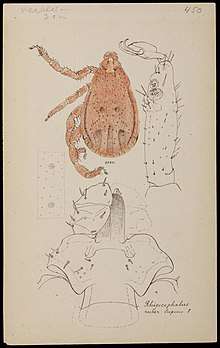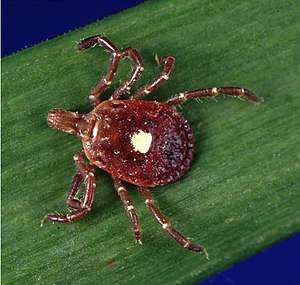Rhipicephalus haemaphysaloides
Rhipicephalus haemaphysaloides is a hard-bodied tick of the genus Rhipicephalus. It is one of the major medically important ticks in the world.
| Rhipicephalus haemaphysaloides | |
|---|---|
 | |
| Scientific classification | |
| Kingdom: | Animalia |
| Phylum: | Arthropoda |
| Subphylum: | Chelicerata |
| Class: | Arachnida |
| Subclass: | Acari |
| Order: | Ixodida |
| Family: | Ixodidae |
| Genus: | Rhipicephalus |
| Species: | R. haemaphysaloides |
| Binomial name | |
| Rhipicephalus haemaphysaloides Supino, 1897 | |
| Synonyms | |
| |
Distribution
It is found in Indonesia, Myanmar, India, Sri Lanka, Thailand, Pakistan, and Vietnam.[1]
Parasitism
It is an obligate ectoparasite of domestic mammals such as cattle, horses, sheep, and dogs. It is a potential vector of babesiosis and human Kyasanur Forest disease.[2][3] It is a three-host tick.[4]
gollark: Yes, they also do that.
gollark: They ridiculously overcentralize the internet.
gollark: I don't like cloudflare, and that wouldn't be "my own DNS servers".
gollark: How did com.com break that? People typing in just "com"? Wouldn't that just resolve to the top level domain?
gollark: I was looking at getting one of those when replacing my bad free .tk domain (there's nothing really wrong with the TLD beyond the registrar being kind of bad, but their free plan allows my use of it to be randomly cancelled and the DNS service is kind of awful), but I just got osmarks.net instead.
References
- "Species Details : Rhipicephalus haemaphysaloides Supino, 1897". Catalogue of Life. Retrieved 11 February 2017.
- Wang, Yujian; Zhou, Yongzhi; Gong, Haiyan; Cao, Jie; Zhang, Houshuang; Li, Xiangrui; Zhou, Jinlin (2015). "Functional characterization of a cystatin from the tick Rhipicephalus haemaphysaloides". Parasites & Vectors. 8: 140. doi:10.1186/s13071-015-0725-5. PMC 4352250. PMID 25889816.
- Bhat, HR; Naik, SV; Ilkal, MA; Banerjee, K (1978). "Transmission of Kyasanur Forest disease virus by Rhipicephalus haemaphysaloides ticks". Acta Virol. 22 (3): 241–4. PMID 27975.
- "Experimental transmission of Babesia microti by Rhipicephalus haemaphysaloides". Li et al. Parasites & Vectors. Retrieved 11 February 2017.
External links
| Wikimedia Commons has media related to Rhipicephalus haemaphysaloides. |
- Lipopolysaccharide-Induced Differential Expression of miRNAs in Male and Female Rhipicephalus haemaphysaloides Ticks
- LIFE CYCLE OF RHIPICEPHALUS HAEMAPHYSALOIDES SUPINO, 1897 (ACARI: IXODIDAE) UNDER LABORATORY CONDITIONS
- Isolation and characterization of two novel serpins from the tick Rhipicephalus haemaphysaloides
- Biological character of Rhipicephalus haemaphysaloides haemaphysaloides in Fujian, China 1992
This article is issued from Wikipedia. The text is licensed under Creative Commons - Attribution - Sharealike. Additional terms may apply for the media files.
